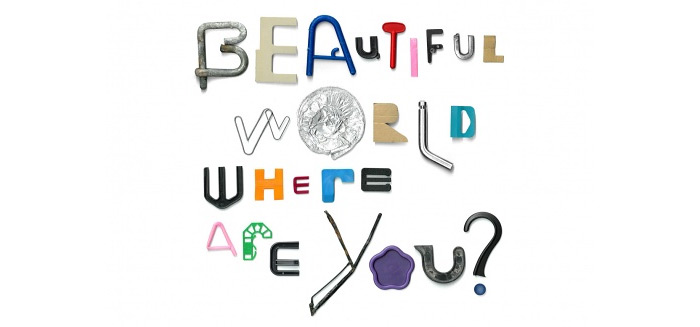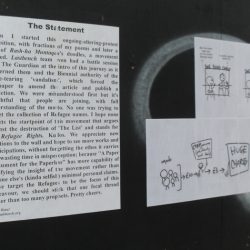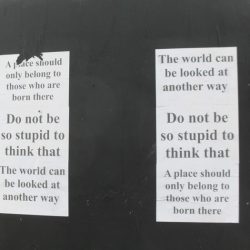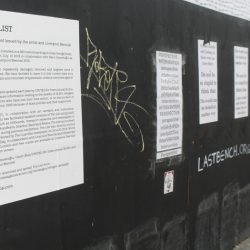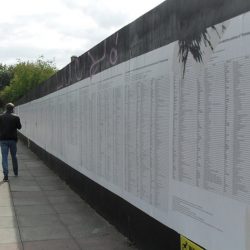Liverpool Biennial 2018
Festival Of Contemporary Art
Runs to 28th October
Reviewed by Joe Coventry
Photographs by Michael Harrison
Under the euphemistically named Beautiful World Where Are You?, the 10th Liverpool Biennial has taken over traditional art venues and communal public spaces across the city. It is often a dark collection of international contemporary works coming to terms with the extremes of political, economic and societal upheaval confronting the world.
With that in mind Great George Street’s endless line of billboards portraying lists of over 34,000 refugees, asylum seekers or migrants who have died in transit to or in the EU since 1993 is a sobering place to start; the more so now that Banu Cennetoglu’s The List is increasingly subject to gratuitous vandalism and where it has been torn down has been replaced in part by some Capitalistic fly posting.
Continuing pessimism continues in the Bluecoat Arts Centre. War and its aftermath are central to Abbas Akhavan’s ‘Variations on a Ghost’, which portrays the remains of a blown up Assyrian 3000 year old protective deity, Lamassu, it’s lions feet and human shin length shattered remains compacted in the artist’s (now disintegrating), ‘dirt-ramming’ technique. It is very evocative of the destruction and mayhem in the internecine struggle for dominance in the Middle East.
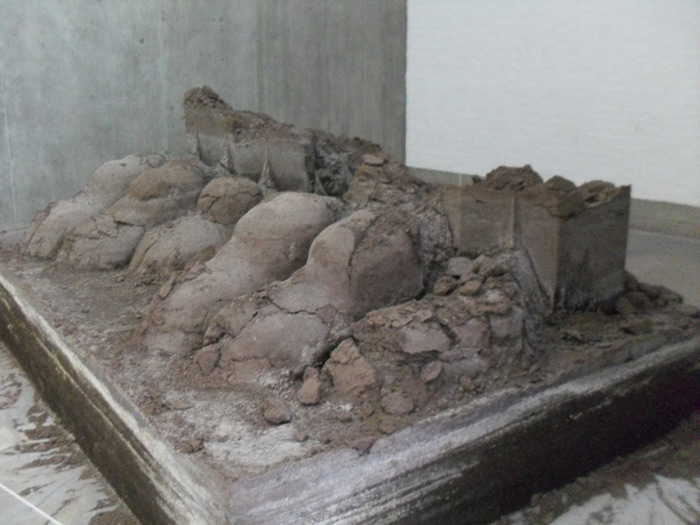
At the same venue is Melanie Smith’s film of the town Maria Elena, struggling to survive in the salt pan blighted Atacama Desert, South America. Its mining community have to survive in one of the most inhospitable places on earth, but at least there is no chance of drowning in the hot saline pools!
In the Playhouse Theatre rehearsal studio Reetu Sattar’s film Harano Sur (Lost Tune) depicts a struggle of a different kind. This is to keep alive the Bangladeshi cultural icon, the harmonium, which is in danger of disappearing as societal and cultural traditions are atomised.
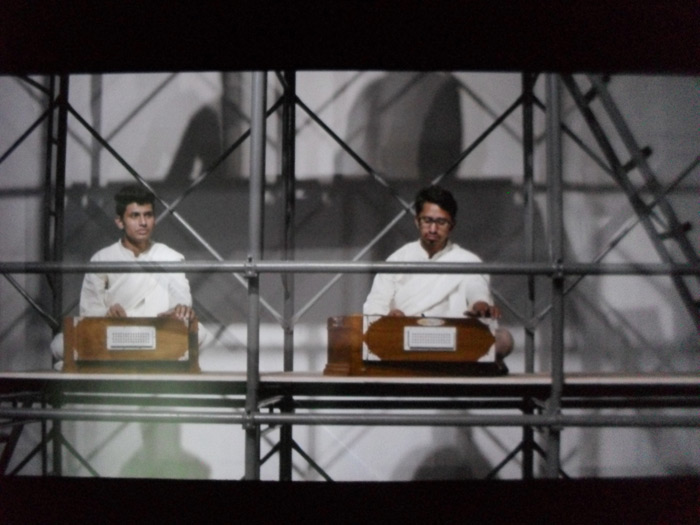
More prosaically over at the Tate Gallery the depiction of Inuit culture is captured in the simplicity and realism of Annie Pootoogook’s drawings, which win out in the 4th Floor Gallery showspace over Kevin Beasley’s Nato issue gas masks and megaphones. ‘Your Face Is/Is Not Enough’ is symptomatic of the whole enterprise.
Running contemporaneously with Director Sally Tallent and guest Curator of Ontario Art Gallery Kitty Smith’s, official selections is the opportunity for local artists to strut their stuff in The Fringe and the old George Henry Lees store is the place to find out what’s on. The building’s cavernous spaces and cruise ship style main staircase have been offered up to groups for six week rolling tenures. the Disparity Collective and Placed were on display when I visited.
In the former show the group looked at what power can mean in 2018 from independent, not stereotyped, perspectives. For photographer Drew Forsyth that was capturing the essence of what Principal Ballerina Bethany Kingsley Garner’s continuous struggle with passion, dedication, fear and triumph meant to her. The latter’s ED Space gave the wider Merseyside public a chance to say how to improve interstitial parts of the town centre that lesser enlightened developers, architects and planners, with less aesthetic considerations on their minds, have contrived to pursue. Something positive from this collaboration, then.
Something to be admired was also being attempted on the outskirts of the city where the Rimrose Valley Friends Environment Trial has been set up by local artists highlighting the fight to conserve the 3.5km Nature Reserve from being turned into a four lane motorway, destroying this vital ‘green lung’ and wildlife haven simply to provide easier access to the nearby Port of Liverpool for HGVs.
The impending threat is evidenced by the (sic) ‘War Of The World’ Martian Red cranes dominating the Seaforth skyline. Another ‘Beautiful World’ hanging in the balance, here guarded for the present by Alice Lenkiewicz’s The Goddess Trail which dissects the proposed Highways England planned route. Greek Earth Mother Gaia and her wicca girls are symbolised on the path in white with a grinning Green Man’s head for luck at the rear.
Away from the fresh air and back in the noise and air pollution of the town centre a breathy trudge up hill to the Victoria Gallery and Museum gets you more disquieting films in opulent surroundings. A rarity in this year’s show is the plein air collection of postcard sized oils painted by Francis Alÿs over the last 30 years, entitled ‘Age Piece’. ‘Outskirts of Mosul’ (2016) is evocative of the sketches done while on location scouting future projects in the likes of Mexico, Iran and Iraq. What could be a village commute is actually a passing group of displaced migrants seeking sanctuary.
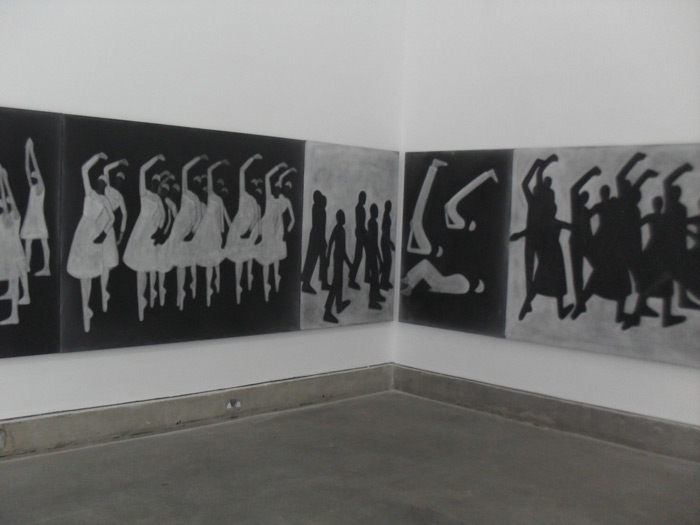
Aslan Gaisumov’s People Of No Consequence shows a room filling with estill proud extant elderly displaced Ingush and Chechens, deported to Central Asia in the 1944 by Russia; the byzantine old mens beards and costumes speaking volumes.
A companion piece to this is his year later (2017) film in St Georges Hall, Keicheyuhea, which has his mother returning to the desolate but breathtakingly beautiful site of her obliterated home 73 years after being evicted. ‘Nothing remains’ she intones, ‘nothing’. Contrast that with the uplifting Bruegel-like animation of Inci Eviner’s ‘Reenactment of Heaven’ if you want to leave more uplifted.
Any review of such an enormous project as this is bound to be subjective and truncated by the ability physically and mentally to digest what is on offer. There is much more to take in and still plenty of time to do so; too much perhaps, once the expectant appetites of the faithful have been honed and sated.
So, Beautiful World Where Are You?
It seems to me that the more leavened attempts to lift the spirits pale in the main behind the darker elements on display. But not all is lost. In RIBA North – National Architecture Centre on the Albert Dock is an underwhelming to look at, but hugely uplifting experience to contemplate in real time. The anonymous sealed plastic cages of ‘In Hack the Root’, by Mae-ling Lokko contain ‘architectural structures’ grown from agrowaste-fed with mycelium mushroom spoors is remarkable.
Getting something for nothing from rotting vegetation that is transformed into organic building material by fungus That equates to a Beautiful World for me. A beacon of hope amid the hell bent race to the cliff edge of global dominance and greed for greed’s sake.
